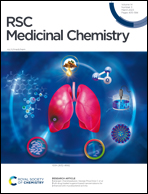Design, synthesis and in vitro cytotoxicity evaluation of indolo–pyrazoles grafted with thiazolidinone as tubulin polymerization inhibitors†
Abstract
In the pursuit of potential and effective chemotherapeutic agents, a series of 2-((3-(indol-3-yl)-pyrazol-5-yl)imino)thiazolidin-4-ones was designed and synthesized, conjoining salient pharmacophoric properties for directing prominent cytotoxicity. The in vitro cytotoxicity evaluation revealed potent compounds with IC50 values <10 μM on tested human cancer cell lines. Compound 6c exhibited the highest cytotoxicity with an IC50 value of 3.46 μM against melanoma cancer cells (SK-MEL-28) and was highly cytospecific and selective towards cancer cells. The traditional apoptosis assays revealed morphological and nuclear alterations such as apoptotic body formation, condensed/horseshoe-shaped/fragmented/blebbing nuclei, and the generation of ROS. Flow cytometric analysis revealed effective early-stage apoptosis induction and cell-cycle arrest in the G2/M phase. In addition, the enzyme-based effect of 6c on tubulin showed the inhibition of tubulin polymerization (about 60% inhibition, IC50 was <1.73 μM). Moreover, molecular modeling studies affirmed the constant accommodation of compound 6c at the active pocket of tubulin, establishing many electrostatic and hydrophobic interactions with the active pocket's residues. The tubulin-6c complex was stable during the MD simulation for 50 ns with the recommended range of RMSD value (2–4 Å) for each pose.



 Please wait while we load your content...
Please wait while we load your content...